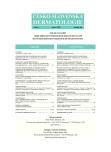-
Medical journals
- Career
Clinical Pathological Aspects of Pendulating Soft Fibroma
Authors: Z. Szép 1,2,3,4; B. Rychlý 1
Authors‘ workplace: CYTOPATHOS, spol. s r. o., laboratórium bioptickej a cytologickej diagnostiky, Bratislava, vedúci spoločnosti doc. MUDr. Dušan Daniš, CSc. 1; Kožné oddelenie, konzultačná a bioptická ambulancia, Nemocnica sv. Michala, Bratislava, vedúci oddelenia prim. MUDr. Ľubomír Zaujec 2; Katedra dermatovenerológie Lekárskej fakulty Slovenskej zdravotníckej univerzity, Bratislava, vedúca katedry doc. MUDr. Klaudia Kolibášová, PhD., mim. prof. 3; Katedra patologické anatomie Lékařské fakulty Univerzity Karlovy v Plzni, vedoucí katedry prof. MUDr. Michal Michal 4
Published in: Čes-slov Derm, 86, 2011, No. 1, p. 33-38
Category: Dermatolohistopatology
Overview
Pendulating fibromas are soft pedunculated processes usually treated by electrocautery shave-excision. Often no histopathological examination is done thus different clinical-pathologic entities might be hidden under the clinical picture of pendulating fibroma. We histologically examined 100 polypoid pendulating lesions clinically diagnosed as soft pendulating fibroma. 45 cases (45%) represented intradermal melanocytic nevi, 32 cases (32%) were fibroepithelial polyps, 13 cases (13%) capillary hemangiomas, 5 cases (5%) seborrhiecfibromas, 3 cases (3%) lipomas/fibrolipomas and 2 cases (2%) represented seborrheic keratoses. 38 (84.4%) of intradermal melanocytic nevi were not totally removed, part of the nevus base remained in the skin after superficial electrocautery shave-excision. Authors discuss the safety/risk of incomplete excision of pendulating intradermal nevi by electrocautery and necessity to perform deeper shave excision to remove the basal part of the lesions.
Key words:
pendulating polypoid lesions – intradermal melanocytic nevi – fibroepithelial polyps –
electrocautery – shave-excision
Sources
1. ARMOUR, K., MANN, S., LEE, S. Dysplastic naevi: to shave, or not to shave? A retrospective study of the use of the shave biopsy technique in the initial management of dysplastic naevi. Australas. J. Dermatol., 2005, 46, 2, p. 70–75.
2. BANIK, R., LUBACH, D. Skin tags: localization and frequencies according to sex and age. Dermatologica, 1987, 174, 4, p. 180–183.
3. BREUNINGER, H., GARBE, C., RASSNER G. Shave excision of melanocytic nevi of the skin: indications, technique, results. Hautarzt, 2000, 51, 8, p. 575–580.
4. COHEN, L. M., HODGE, S. J., OWEN, L. G. et al. Atypical melanocytic nevi. Clinical and histopathologic predictors of residual tumor at reexcision. J. Am. Acad. Dermatol., 1992, 27, 5 Pt 1, p. 701–706.
5. DUMMER, R. About moles, melanomas, and lasers: the dermatologist´s schizophrenic attitude toward pigmented lesions. Arch. Dermatol., 2003, 139, 11, p. 1405–1406.
6. DUMMER, R., KEMPF, W., BURG, G. Pseudo-melanoma after laser therapy. Dermatology, 1998, 197, 1, p. 71–73.
7. FRANKEL, K. A. Basal cell carcinoma arising in a fibroepithelial polyp. J. Am. Acad. Dermatol., 1993, 29, 6, p. 1059–1060.
8. FREDRIKSSON, C. H., ILIAS, M., ANDERSON, C. D. New mechanical device for effective removal of skin tags in routine health care. Dermatol. Online J., 2009, 15, 2, p. 9.
9. GOODSON, A. G., FLORELL, S. R., BOUCHER, K. M. et al. Low rates of clinical recurrence after biopsy of benign to moderately dysplastic melanocytic nevi. J. Am. Acad. Dermatol., 2010, 62, 4, p. 591–596.
10. KASKEL, P., KIND, P., SANDER, S. et al. Trauma and melanoma formation: a true association? Br. J. Dermatol., 2000, 143, 4, p. 749–753.
11. KING, R., HAYZEN, B. A., PAGE, R. N. et al. Recurrent nevus phenomenon: a clinicopathologic study of 357 cases and histologic comparison with melanoma with regression. Mod. Pathol., 2009, 22, 5, p. 611–617.
12. KNEZEVIC, F., DUANCIC, V., SITIC, S. et al. Histological type of polypoid cutaneous melanoma II. Coll. Antropol., 2007, 31, 4, p. 1049–1053.
13. KORNBERG, R., ACKERMAN A. B. Pseudomelanoma. Recurrent melanocytic nevus following partial surgical removal. Arch. Dermatol., 1975, 111, 12, p. 1588–1590.
14. KRUPASHANKAR, D. S. et al. Standard guidelines of care: CO2 laser for removal of benign skin lesions and resurfacing. Indian. J. Dermatol. Venereol. Leprol., 2008, 74, Suppl, p. S61–67.
15. LANGEL, D. J., WHITE, W. L. Pseudomelanoma after non-biopsy trauma – expanding the spectrum of persistent nevi. J. Cutan. Pathol., 2000, 27, p. 562.
16. LORTSCHER, D. N., SENGELMANN, R. D., ALLEN, S. B. Acrochordon-like basal cell carcinomas in patients with basal cell nevus syndrome. Dermatol. Online J., 2007, 13, 2, p. 21.
17. MCKEE, H. Ph. et al. Pathology of the skin with clinical correlations. 3.vyd., Elsevier Mosby, 2005, p.1708–1709. ISBN 9780323036726.
18. MUKHTAR, M. Surgical pearl: tissue forceps as a simple and effective instrument for treating skin tags. Int. J. Dermatol., 2006, 45, 5, p. 577–579.
19. REDA, A. M., TAHA, I. R., RIAD, H. A. Clinical and histological effect of a single treatment of normal mode alexandrite (755nm) laser on small melanocytic nevi. J. Cutan. Laser Ther., 1999, 1, 4, p. 209–215.
20. SHAW, H. M., THOMPSON, J. F. Polypoid melanoma is not rare. Br. J. Dermatol., 1996, 135, 2, p. 333–334.
21. SELLHEYER, K., BERGFELD, W. F., STEWART, E. et al. Evaluation of surgical margins in melanocytic lesions: a survey among 152 dermatopathologists. J. Cutan. Pathol., 2005, 32, 4, p. 293–299.
22. TROYANOVA, P. The role of trauma in the melanoma formation. J. BUON, 2002, 7, 4, p. 347–350.
Labels
Dermatology & STDs Paediatric dermatology & STDs
Article was published inCzech-Slovak Dermatology

2011 Issue 1-
All articles in this issue
- Hidradenitis suppurativa
- Skin Changes after Renal Transplantation: the First Results of Clinical Follow-up
- Successful Treatment of Severe Hidradenitis Suppurativa with Adalimumab
- Autoimmune Hepatitis during by Infliximab Treatment of Psoriasis: Case Report
- Clinical Pathological Aspects of Pendulating Soft Fibroma
- Czech-Slovak Dermatology
- Journal archive
- Current issue
- Online only
- About the journal
Most read in this issue- Successful Treatment of Severe Hidradenitis Suppurativa with Adalimumab
- Hidradenitis suppurativa
- Clinical Pathological Aspects of Pendulating Soft Fibroma
- Autoimmune Hepatitis during by Infliximab Treatment of Psoriasis: Case Report
Login#ADS_BOTTOM_SCRIPTS#Forgotten passwordEnter the email address that you registered with. We will send you instructions on how to set a new password.
- Career

